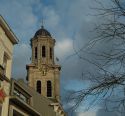Lokeren: Hellish War – Heavenly Peace
When cycling through this beautiful part of Waasland, it is hard to imagine that it was once the scene of an 80-year war during the late 16th century and the first half of the 17th century! Why would one fight for 80 years? Religion! In addition, at the end of the 18th century, French rule was the final blow to many religious institutions! Monasteries, abbeys and churches were confiscated and sold to be demolished or given a new secular purpose.
This is the region where Christianisation broke out and where the great mighty abbeys dominated. Nowadays it is best known for its heavenly nature and quiet areas.
This cycle route departs from Lokeren. Via the railway bed you will reach Eksaarde, Daknam and Moerbeke-Waas. Follow the waterways to Klein-Sinaai, Sinaai and Belsele. Via Waasmunster and Ruiter we return to Lokeren.
The free cycling brochure 'Helse oorlog- Hemelse vrede' (NL) is available from the Tourist Services of Lokeren, Moerbeke-Waas, Sint-Niklaas, Stekene and Waasmunster. The brochure is also available in the open church OLV Ascension Church in Klein-Sinaai as well as in several other churches along the route.
Continue on PC Download PDF Continue on mobile
-
Sint-Laurentius Church – Lokeren
The church appears in its present form around 1719-1725 after the old church was destroyed by a severe fire. In addition to the extremely airy interior, the 66.2m high tower, the so-called Peperbus, is particularly striking. In the tower is a carillon with 49 bells (...)
-
Heirbrug Mill – Lokeren
More than a century ago there were at least 35 mills in Lokeren. Today there remains one, the Heirbrugmolen. The current stone mill dates from 1837 and was fully restored and milled in 2002. Striking is the open space around the mill (...)
-
Onze-Lieve-Vrouw Church – Daknam
Anyone entering Daknam will be immediately charmed by the village square and the old church! The church was already there in the 12th century and was expanded in the 15th century with a southern party and a larger choir. A fire in the 17th century unfortunately destroyed part of the old church (...)
-
Onze-Lieve-Vrouw Hemelvaart Church – Eksaarde
Eksaarde was said to have been christianised by Amandus van Gent as early as the 7th century and became a separate parish in 1230. The present church dates from this last period. Since Eksaarde, as a border town, was in the front line during the religious wars, the passage of the Geuzen was devastating for the Romanesque church (...)
-
Kruis Chapel – Eksaarde
The Cross Chapel was built in 1632 on the site where, according to legend, two miraculous crosses were found in 1317. The masonry well near the cross chapel indicates the exact place where a certain Baudouin with the Nine Pounds dug up the crosses (...)
-
Sint-Antonius Abbey Church – Moerbeke
Little is known about the exact origin of the church. It is generally assumed that the church largely dates from the 14th-early 15th century. Some repairs were carried out in the course of the 17th century after the devastating religious wars (...)
-
O.-L.-Vrouw-Onbevlekt-Ontvangen – Klein-Sinaai
In 1636, 60 years after the destruction of the abbey, the monks built a small church for the inhabitants of Klein-Sinaai. After the French Revolution, this display of solidarity with the abbey was not tolerated. The church was sold by the French rulers and finally demolished in 1822 (...)
-
Sint-Catharina Church – Sinaai
The church of Sinaai dates from 1267 but was thoroughly renovated and enlarged around 1841-1844 by the Ghent architect Lodewijk Roelandt in the neo-Byzantine style. The church is dedicated to Saint Catherine of Alexandria, a popular medieval saint from whom we would not want to deny you her life story (...)
-
Sint-Andreas en Sint-Ghislenus Church – Belsele
Parish church of St. Andrew and Gislenus is a Gothic cruciform church in the centre of the village. North of it, a car park replaces the cemetery that was dissected in 1943. Part of the iron fence was reused in the Kerkstraat (...)
-
Heide Chapel – Waasmunster
The Heide Chapel was built in 1643 in the middle of the wooded Heath on the old Ghent-Antwerp road. There would have been a Gothic chapel in the past, but it was largely destroyed during the religious turbulence. The chapel is dedicated to Our Lady of 7 contractions (...)
-
OLV-en-Sint-Petrus-en-Paulus Church – Waasmunster
Waasmunster is called the mother parish of the Waasland. It was already christianised around 800 AD. With the foundation of the abbey of Roosenberg on the banks of the Durme, it became one of the ecclesiastical centres of the Waasland (...)
-
Roosenberg Abbey – Waasmunster
The abbey was founded in the 13th century and was initially located on the banks of the Durme. Despite the devastation and difficulties during the religious wars, the abbey continued to exist until French rule brutally put an end to it (...)
-
Sint-Jan Baptist Church – Ruiter
The rural hamlet of Ruiter was created on the old Hoge Heerweg between Ghent and Antwerp. The name of the hamlet comes from the inn Zwarte Ruiter (black rider) which was already there around 1600. Between 1877 and 1880, the village was given a church dedicated to John the Baptist (...)



